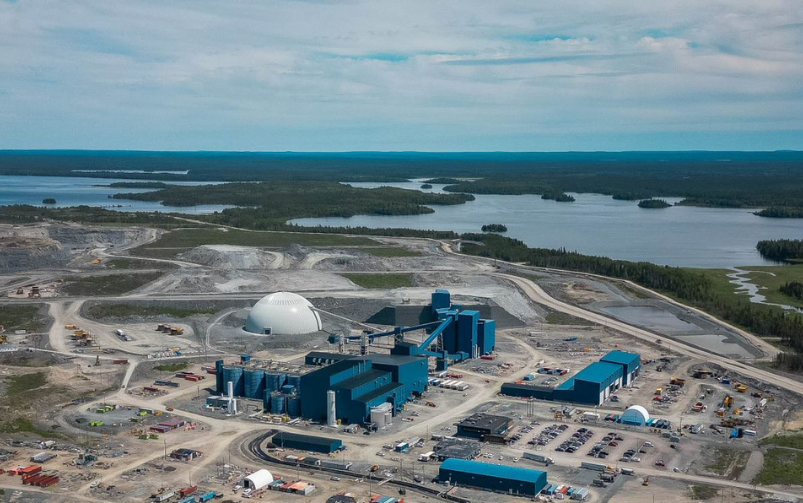Alamos Gold's Island Gold mine in Ontario. The company has secured a place on Mining.com’s Top 50 ranking of the world’s most valuable miners for the first time, following the recent closing of its acquisition of Argonaut Gold. Photo courtesy of Alamos Gold.
Welcome back to your weekly mining news recap, where we catch you up on some of the news you may have missed. This week’s headlines include Amazon’s nuclear investments, FPX Nickel’s battery-grade nickel sulfate production and an international mining standard presented for public consultation.
The Canadian Mining Hall of Fame (CMHF) has inducted Sean Boyd, Frank Giustra, Donald Roderick MacLean and Patricia Ann Sheahan. The four inductees have contributed to Canada’s mining industry in areas such as corporate management, mine financing, underground mine safety and industry communications. They will be recognized at the CMHF’s annual gala dinner, on Jan. 9, 2025, in Toronto.
NexGold Mining and Signal Gold plan to merge to form a major Canadian gold developer, as reported by Mining Technology. The new entity, which will be called NexGold, is aiming to produce more than 200,000 ounces of gold per year. The transaction will merge the Goliath gold complex in northern Ontario with the Goldboro gold project in Nova Scotia. Both projects have secured environmental approvals and permits for both are expected in 2025.
The world’s 50 largest mining companies are now valued at a collective US$1.5 trillion, reflecting an increase of almost US$76 billion in the third quarter of 2024, primarily driven by the rise of gold miners, as reported by Mining.com. Alamos Gold joined the top 50 list for the first time thanks to its acquisition of Argonaut Gold, which boosted its value. Other Canadian companies that made the list include Agnico Eagle (12), Barrick Gold (16), Wheaton Precious Metals (17) and Teck Resources (18).
Amazon has signed three agreements to develop small modular nuclear reactors (SMRs) to address increasing electricity demand from its data centres, as reported by Reuters. The company will finance a feasibility study for an SMR project in Washington state, developed by X-Energy, a U.S. nuclear reactor and fuel company, and it is also leading a US$500 million funding round to support X-Energy’s SMR development. Amazon signed additional deals with utilities in Washington state and Virginia to explore the development of SMR projects.
FPX Nickel has successfully produced battery-grade nickel sulfate from pilot-scale hydrometallurgy tests at its Baptiste nickel project in central B.C., a milestone that is moving it closer to establishing North America’s largest nickel sulfate refinery, as reported by Canadian Mining Journal. The pilot tests achieved high leach extraction rates of 99.3 per cent for nickel and 97.9 per cent for cobalt.
The Consolidated Mining Standard Initiative (CMSI)—a collaboration of Copper Mark, the Mining Association of Canada, ICMM and the World Gold Council—released a draft standard on Oct. 16 and is inviting public feedback during a 60-day consultation period. The CMSI seeks to streamline standards from each individual organization and promote environmental, social and governance practices across the metal and mineral value chains, with the goal of widespread adoption by mining companies across the globe. A second consultation period is expected next year.
E3 Lithium has completed its direct lithium extraction (DLE) pilot project and is now advancing plans for a demonstration facility to produce battery-grade lithium carbonate from brines found in Alberta’s Leduc reservoir. E3 stated that the project validated the effectiveness of its DLE technology and produced key data that was included in the company’s recently released prefeasibility study for its Clearwater lithium brine project in Alberta.
Surveys using environmental DNA (eDNA) are allowing mining companies to better monitor biodiversity across large areas, helping assess their environmental impact throughout a mine’s lifespan, as reported by Lynn Grenier for the September/October issue of CIM Magazine. Analyzing eDNA allows for quicker and more cost-effective assessments compared to traditional biodiversity surveys, as eDNA can be collected from larger areas and more diverse habitats without requiring extensive field expertise.
Pierre-Claude Ostiguy, director of the acoustics and vibration monitoring division at Soft dB, spoke with Mehanaz Yakub in the September/October issue of CIM Magazine about the importance of effective noise and vibration monitoring at mine sites to ensure regulatory compliance and improve community relations. With real-time monitoring systems, mines can swiftly address compliance concerns and mitigate noise complaints, especially from specific sounds that may disrupt locals.
That’s all for this week. If you’ve got feedback, you can always reach us at editor@cim.org. If you’ve got something to add, why not join the conversation on our Facebook, Twitter, LinkedIn or Instagram pages?




